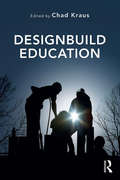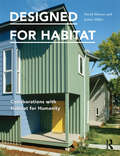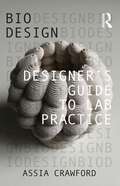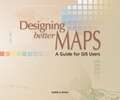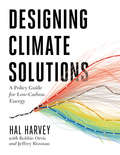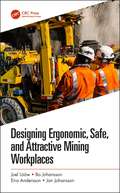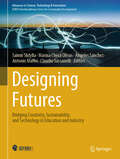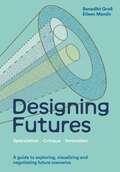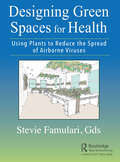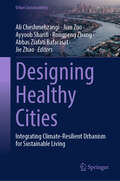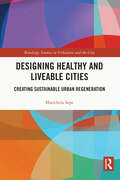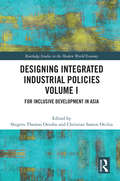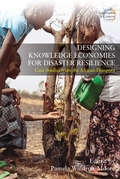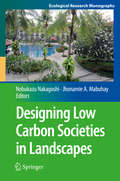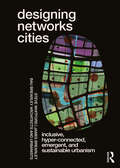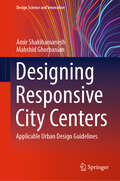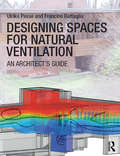- Table View
- List View
Designbuild Education
by Chad KrausDesignbuild Education adopts the intellectual framework of American Pragmatism, which is a theory of action, to investigate architects’ compelling urge to build and how that manifests in collegiate designbuild programs. Organized into four themes—people, poetics, process, and practice—the book brings together new essays by some of today’s most well-known designbuild educators, including Andrew Freear from Rural Studio and Dan Rockhill from Studio 804, to shed light on the theoretical dimensions of their practice and work. Illustrated with over 100 black and white images.
Designed Landscapes: 37 Key Projects
by Alan Tate Marcella EatonDesigned Landscapes is a case-by-case study of 37 significant, existing works of landscape design worldwide, largely constructed since the Renaissance. Being an informative and easy-to-read reference volume for practitioners and students alike, it presents key precedents in landscape architecture using site plans and recent photographs to showcase each project. Organised and presented in 12 sections based on project type, each project is examined based on date, previous site condition, designer(s), design intentions, current composition, unique features, ownership and management, and comparable projects. Each chapter offers an insightful critique of the featured projects. Written by the authors of Great City Parks, the book posits that these carefully selected key projects have maintained their status throughout the ages because they express values and design intentions that continue to inform the practice of the landscape architecture in the present day. The book concludes with a ten-point summary of lessons for professional practice gleaned from the studies. Including a wide range of case studies from countries including many in western Europe, the United States, Canada, India, Japan and China, and lavishly illustrated with over 200 full-colour images, the book is a must-have volume for anyone interested in the history and current practice of landscape architecture.
Designed for Habitat: Collaborations with Habitat for Humanity
by Justin Miller David HinsonIf you're looking for ways to give back to your community, then this book, the first to profile thirteen projects designed and built by architects and Habitat for Humanity, will help. Detailed plans, sections, and photographs show you how these projects came about, the strategies used by each team to approach the design and construction process, and the obstacles they overcame to realize a successful outcome. The lessons and insights, presented here will aid you, whether you're an architect, architecture student, Habitat affiliate leader, or an affordable housing advocate. Located all across the United States, these projects represent the full spectrum of Habitat for Humanity affiliates, from large urban affiliates to small rural programs. These cases illustrate a broad range of innovative approaches to energy performance, alternative construction strategies, and responses to site context. And each house demonstrates that design quality need not fall victim to the rigorous imperatives of cost, delivery, and financing.
Designed for Habitat: New Directions for Habitat for Humanity
by Justin Miller David HinsonDesigned for Habitat: New Directions for Habitat for Humanity presents 12 new projects designed and built via collaborations between architects and Habitat for Humanity®. The ways in which we think about affordable housing are being challenged by designers and not-for-profit housing advocates such as Habitat for Humanity and its affiliates. The projects chronicled in this book consider home affordability through the lens of monthly homeownership expenses, energy efficiency and residential energy use, and issues of designed resilience to natural events ranging from aging and accessibility concerns to natural disasters and climate change. New to this edition, the projects reflect new approaches to building scale, construction technology, energy and affordability, and design and context. Illustrated with over 100 color images, the case studies include detailed plans and photographs to show how these projects came about, the strategies used by each team to approach the design and construction process, and the obstacles they overcame to realize a successful outcome. The lessons and insights presented will be a valuable resource, whether you’re an architect, an architecture student, a Habitat affiliate leader, or an affordable housing advocate.
Designers Visionaries and Other Stories: A Collection of Sustainable Design Essays
by Jonathan ChapmanDesigners, Visionaries and Other Stories unpacks the complex and crucial debates surrounding sustainable design to deliver a compelling manifesto for change, at a time of looming ecological crisis, mounting environmental legislation and limited progress. This is a book about sustainable design, by the leading sustainable design thinkers, for creative practitioners, professionals, students and academics. This challenging work provides the reader with a rich resource of future visions, critical propositions, creative ideas and design strategies for working towards a sustainable tomorrow, today. The authors boldly present alternative understandings of sustainable design, to curate a challenging, sometimes uncomfortable and always provocative, collection of essays by some of the worlds leading sustainable design thinkers. The result is an impacting and polemical anthology that reinvigorates the culture of critique that, in previous years, has empowered design with the qualities of social, environmental and economic revolution.
Designer’s Guide to Lab Practice (Bio Design)
by Assia CrawfordThis book explores the growing field of bio-design through interdisciplinary creative practice. The volume illustrates a range of experimental working techniques while offering a foundational understanding of lab practice principles. The book highlights the myriad of opportunities presented by microorganisms that have reshaped the planet and made it habitable. The book provides an account of the creation of living materials from the point of view of an architectural design practitioner. The transition from traditional design practice to laboratory investigation is captured, highlighting strategies of creating partnerships across a range of fields. The book demonstrates laboratory methods and ways of investigating the development of living materials and celebrates the growing body of practitioners, scientists, activists and anthropologists who are reimagining new strategies for addressing contemporary environmental challenges. Designer's Guide to Lab Practice looks at ways in which integrating living components with needs of their own would not only help offset the environmental impact that we have on our planet but could also create a closer relationship with nature. It is a working manual as well as a guide to emerging practitioners seeking to transition into a field that is yet to be defined and that offers the promise of a new era of human habitat making as a direct response to the looming ecological crisis.
Designing Better Maps: A Guide For GIS Users
by Cynthia A. BrewerDescribing how to build balanced map layouts suited to varied mapping goals, this guide focuses on export options that suit different media and can be edited in other applications. The wide range of text characteristics needed for expert map design as well as how to improve map readability with type effects such as character spacing, leading, callouts, shadows, and halos is detailed. Tips are included for using font tools in the Windows operating system, such as creating special characters in map text, as is information on using text characteristics to indicate feature locations, categories, and hierarchies on maps. How cartographic conventions guide placement of labels for point, line, and area features are also explained.
Designing Climate Solutions: A Policy Guide for Low-Carbon Energy
by Hal Harvey Robbie Orvis Jeffrey RissmanWith the effects of climate change already upon us, the need to cut global greenhouse gas emissions is nothing less than urgent. It's a daunting challenge, but the technologies and strategies to meet it exist today. A small set of energy policies, designed and implemented well, can put us on the path to a low carbon future. Energy systems are large and complex, so energy policy must be focused and cost-effective. One-size-fits-all approaches simply won't get the job done. Policymakers need a clear, comprehensive resource that outlines the energy policies that will have the biggest impact on our climate future, anddescribes how to design these policies well.Designing Climate Solutions:A Policy Guide for Low-Carbon Energy is the first such guide, bringing together the latest research and analysis around low carbon energy solutions. Written by Hal Harvey, CEO of the policy firm Energy Innovation, with Robbie Orvis and Jeffrey Rissman of Energy Innovation, Designing Climate Solutions is an accessible resource on lowering carbon emissions for policymakers, activists, philanthropists, and others in the climate and energy community. In Part I, the authors deliver a roadmap for understanding which countries, sectors, and sources produce the greatest amount of greenhouse gas emissions, and give readers the tools to select and design efficient policies for each of these sectors. In Part II, they break down each type of policy, from renewable portfolio standards to carbon pricing, offering key design principles and case studies where each policy has been implemented successfully.We don't need to wait for new technologies or strategies to create a low carbon future—and we can't afford to. Designing Climate Solutions gives professionals the tools they need to select, design, and implement the policies that can put us on the path to a livable climate future.
Designing Ergonomic, Safe, and Attractive Mining Workplaces
by Jan Johansson Joel Lööw Bo Johansson Eira AnderssonThe mining industry has experienced important improvements with regard to its safety record and work environment. But there is still room for further improvement and the mining industry now faces the challenge of securing a future workforce: The current workforce is aging, and mining work increasingly requires a more qualified workforce. Designing Ergonomic, Safe, and Attractive Mining Workplaces seeks to give an understanding of what must be considered in the design of mining workplaces. By reviewing and discussing the historic and current development of the mining industry as well as problems related to the safety, ergonomics, and attractiveness of mining workplaces, it demonstrates that the challenges facing the mining industry often need to be solved on a case-to-case basis. The processes through which these issues are managed are of significant importance. To facilitate a proactive approach, the book covers the principles of systematic work environment management, together with examples of methods for risk management and work environment monitoring. It introduces a systematic and iterative design and planning method for the mining industry. This method acknowledges that all relevant stakeholders must be able to influence the design of ergonomic, safe, and attractive mining workplaces. Features Takes a holistic and sociotechnical approach to current and future problems of the mining industry, which normally are dealt with in isolation or through technology Reviews historic, current, and future issues in the mining industry with regards to workplace attractiveness, health, safety, mechanization, automation, and work organization Provides several examples of these issues and attempts to address them (successfully and unsuccessfully) Covers the principles of systematic work environment management together with examples of methods for risk management and work environment monitoring for pro-actively dealing with work environment issues Introduces a systematic and iterative design and planning method for the mining industry that aims to avoid problems of traditional planning approaches and increase stakeholder and employee participation
Designing Futures: Bridging Creativity, Sustainability, and Technology in Education and Industry (Advances in Science, Technology & Innovation)
by Angeles Sánchez Marina Checa Olivas Saimir Shtylla Antonio Maffei Claudio SassanelliThis book is a compelling exploration into the integration of sustainability with creativity and technology. It offers a cohesive journey from theoretical insights into practical applications across creative disciplines, education, and industries. This book serves as a crucial guide for those looking to navigate the challenges of modern sustainability through innovative solutions. By showcasing examples from 3D printing in education to sustainable practices in creative industries and the preservation of cultural heritage through digital innovation, it highlights the transformative power of creativity in fostering a sustainable future. Aimed at academics, professionals, and students, this book is an invitation to engage, innovate, and contribute to the sustainability discourse in the creative sectors.
Designing Futures: Speculation, Critique, Innovation
by Benedikt Groß Eileen MandirThe ability to imagine different possible futures and the will to influence the course of events are deeply human. These ideas about the future can also determine which of the many possible futures will become reality. Designing futures therefore means that by creating and communicating potential scenarios, you can shape the futures of your fellow human beings and influence the course of events. Design is becoming more strategic as a discipline, moving away from 'making things beautiful' to 'thinking creatively'. This book provides designers with the methods and tools they need to develop discussable and tangible scenarios. It also outlines ways for creative people, activists and decision-makers in politics, science and the wider society to imagine more desirable futures.- With over 500 illustrations.- Case studies from across the world.- Foreword by Riel Miller, senior fellow at the École des Ponts Business School, the University of Stavanger and the University of New Brunswick.
Designing Futures: Speculation, Critique, Innovation
by Benedikt Groß Eileen MandirThe ability to imagine different possible futures and the will to influence the course of events are deeply human. These ideas about the future can also determine which of the many possible futures will become reality. Designing futures therefore means that by creating and communicating potential scenarios, you can shape the futures of your fellow human beings and influence the course of events. Design is becoming more strategic as a discipline, moving away from 'making things beautiful' to 'thinking creatively'. This book provides designers with the methods and tools they need to develop discussable and tangible scenarios. It also outlines ways for creative people, activists and decision-makers in politics, science and the wider society to imagine more desirable futures.- With over 500 illustrations.- Case studies from across the world.- Foreword by Riel Miller, senior fellow at the École des Ponts Business School, the University of Stavanger and the University of New Brunswick.
Designing Green Spaces for Health: Using Plants to Reduce the Spread of Airborne Viruses
by Stevie FamulariThis book focuses on using plants in spatial design to reduce the infectiousness of viruses in different working and living spaces. It presents strategies for interior and exterior green designs with plants that are likely effective for flu virus tolerance and reduction of infectiousness. The designs are appealing for interaction and healing, as well as focusing on the reduction and removal of virus infectiousness. The Famulari Theory requires examining plants that are likely effective for virus accumulation based on their leaves with stomata, trichomes, and dense leaf growth, and transpiration rate accumulation of airborne viruses. In addition, this research requires reviewing the quantity and specific types of plants (as well as electronic sources, such as humidifiers and water features) needed to produce effective humidity for plants to decrease the infectiousness or transmission of viruses; the effective distance of people to plants; and light, water, soil, and temperature needs. The book addresses the various greening practices that can be applied to sites to reduce the infectiousness of the airborne flu virus – especially in areas such as train stations, restaurants, rooftops, courtyards, office buildings and work spaces/conference rooms, and the home office – and the ways that businesses owners and residents can integrate these practices to reduce the air contaminants with a green solution. Designing green spaces that accumulate, reduce, and remove the infectiousness of viruses involves exploring multiple approaches from different directions to achieve the most effective and ideal design. The six basic approaches include 1. Temperature minimum of 70° Fahrenheit 2. Plants with multiple stomata on the leaf surfaces 3. Plants with multiple clumps of dense leaves with a high transpiration rate 4. Plants with rough leaf surfaces or with trichomes (plant hairs) on the leaf 5. Relative humidity (RH) minimum of 43% or higher 6. Air circulation to direct air with the airborne flu virus to the planted areas Stevie Famulari brings unique insights and inspires the development of green understanding and design solution plans with both short-term and long-term approaches. Illustrations of greening applied to locations help you understand your own design solutions to create them in your site. This book breaks down the misconceptions of the complexity of sustainability and green practices and provides illustrations and site-appropriate green solutions that you can incorporate into your lifestyle for a healthier site. Greening is a lifestyle change, and this guide lets you know how easy it is to transition to the green side to improve your health.
Designing Healthy Buildings and Communities: Shaping a Climate-Resilient Future (Urban Sustainability)
by Jian Zuo Ali Cheshmehzangi Ayyoob Sharifi Rongpeng Zhang Abbas Ziafati Bafarasat Jie ZhaoThis book aims to explore and showcase global case studies focused on creating buildings and communities that promote health while enhancing climate resilience. In an era where climate change increasingly impacts urban environments, there is a critical need for innovative solutions that go beyond conventional practices. This book compiles a diverse range of examples, drawing on real-life projects and potential paradigm shifts that emphasise novel ideas and advanced methodologies. The featured case studies span various aspects of building and community design, including architectural design directions, technology integration, and technical methods. Each contribution provides practical examples that illustrate the implementation of these concepts in real-world settings. By highlighting innovative approaches, the book challenges the status quo and encourages a shift from business-as-usual scenarios to forward-thinking strategies that prioritise both human health and environmental sustainability. Key themes include the integration of green building technologies, the adoption of sustainable materials, and the incorporation of nature-based solutions in community design. Additionally, the book delves into community-driven initiatives that foster social cohesion and climate-resilience, demonstrating how collaborative efforts can lead to more robust and adaptable cities. Through detailed analyses and comprehensive discussions, this book serves as a vital resource for architects, urban planners, policymakers, and researchers. It provides insights into cutting-edge practices and offers inspiration for future projects aimed at creating a healthier and more sustainable future. By bringing together these global perspectives, the book highlights the importance of innovation and adaptability in the face of climate challenges, ultimately contributing to the development of sustainable and thriving urban landscapes.
Designing Healthy Cities: Integrating Climate-Resilient Urbanism for Sustainable Living (Urban Sustainability)
by Jian Zuo Ali Cheshmehzangi Ayyoob Sharifi Rongpeng Zhang Abbas Ziafati Bafarasat Jie ZhaoThis book investigates how urban planning can promote inclusive, climate-resilient, and healthy communities. With cities worldwide battling the twin problems of increasing urbanization and the intensifying effects of climate change, this book offers a relevant, multidisciplinary framework for rethinking urban areas to support equity, well-being, and environmental sustainability. The book explores the connections between environmental resilience, urban planning, and public health, grounded in state-of-the-art research and enhanced by real-world case studies. It emphasizes how urgent it is for cities to adopt proactive, forward-thinking design strategies in order to both adapt to and lessen the effects of climate change. The book offers practical advice for designing areas that are useful and improve city dwellers' physical and emotional health by fusing sustainable urbanism with human-centered methodologies. The book emphasizes the necessity of adopting comprehensive, integrated approaches to urban development from a forward-looking standpoint. It urges people to change their perspective from seeing cities only as centers of economic activity to seeing them as living ecosystems that support and care for their residents. By doing this, the book hopes to motivate a new generation of urban leaders and thinkers who are committed to creating cities that coexist peacefully with the environment. It also gives the readers the essential knowledge and resources to help create a sustainable and resilient urban future, whether they are practitioners influencing urban policy or citizens who are enthusiastic about fostering healthier living conditions.
Designing Healthy and Liveable Cities: Creating Sustainable Urban Regeneration (Routledge Studies in Urbanism and the City)
by Marichela SepeIn the last ten years, concepts such as urban health and liveability have become ever more present in urban planning studies. Many companies rank the most liveable city in the world or in a nation, and many indicators are used to try to measure factors which can report the health of a place by investigating it in different ways. While it is possible to understand why a place is liveable – due to the liveability and health concepts that are being more and more explored in urban studies, and the strong influence coming from other disciplines – it is difficult to design a place that is certain to be healthy and liveable. Accordingly, aim of this book is, after the definition of the field of investigation concerning sustainable regeneration trough topics such as resilience, adaptation, health, and mixed connections, to illustrate the present-day approaches to the analysis and design of healthy places, and in particular the original Healthy Pl@ce Design method, flexible and repeatable in different contexts. The method aims to identify sustainable urban liveability and healthiness and the factors which make places liveable and healthy from users' points of view and identifying design interventions that can enhance or create both urban liveability and health. Emblematic case studies carried out in Europe, Canada and China – Bordeaux, Copenhagen, Hamburg, Madrid, Newcastle–Gateshead, Nice, Dublin, Vancouver and Wuhan – constitute the empirical part of the book, detailed with surveys, questionnaires, images and maps. The theoretical framework – built on contemporary issues – and international case studies make this book both attractive and scientific, adding a new stone on the sustainable city construction and opening it to a particularly wide readership, including scholars, students, administrators and professionals.
Designing Innovative Corporate Water Risk Management Strategies from an Ecosystem Services Perspective
by Emily Taylor Berry Kennedy Don Scavia Makely Lyon Joshua Rego Daniel Gerding Andrew Hoffman Neil HawkinsAccess to water is essential for almost all aspects of the economy and quality of life; in particular, for health, food production and security, domestic water supply and sanitation, energy, industry, and ecosystem health. Yet, water scarcity already affects more than 40 percent of the global population, and by 2025, it is estimated that and two-thirds of the world’s population will be living in regions where water supplies are stressed and 1.8 billion people will be living in countries or regions with absolute water scarcity. By 2030, it is estimated that 47 percent of the global population will be living in high water stress areas. The authors of this book survey common organizational (both public and private) responses to water scarcity across three categories--technology-based, policy-based, and management-based--and then focus on the latter as holding the most promise for creating a robust, organization-wide solution for potential freshwater scarcity. Management-based responses are those developed within the organization to internalize water-related externalities.
Designing Integrated Industrial Policies Volume I: For Inclusive Development in Asia (Routledge Studies in the Modern World Economy)
by Shigeru Thomas OtsuboThis comprehensive reference work gives an overview of the industrial development and current state of industrialization and deindustrialization in Asia, specifically Southeast Asia and China. It introduces typologies of industrial policies and discusses the manufacturing sector and its evolving role in the region. Designing Integrated Industrial Policies examines the integration of SMEs in global value chains and provides macro-econometric and firm-based micro-econometric analyses of (de)industrialization. This book will be a very useful reference particularly as a how-to guide on industrial promotion and designing integrated industrial policies not only for economic growth and job creation but also for "inclusive" development. It presents country cases and illustrates useful tools for industrial policy simulation and for evidence-based policy making through these concrete examples.
Designing Knowledge Economies for Disaster Resilience: Case Studies from the African Diaspora (Catastrophes in Context #7)
by Pamela Waldron-MooreDisaster research has been studied from many angles, seldom targeting its implications for vulnerable territories in Africa. Entities most subject to the effects of climate change are often undeveloped and located in disadvantaged regions. Post-disaster communities need to scrutinize the social, political, economic, and cultural structures that stagnate sustainable growth. Acknowledging that low economic development and high climate costs cannot coexist, this collected volume interrogates the challenge for disaster-prone territories to determine strategies for restructuring and redesigning their environment. This book proposes the creation of knowledge economies, whereby empowered communities may produce innovative knowledge translatable across the African diaspora.
Designing Landscape Architectural Education: Studio Ecologies for Unpredictable Futures
by Rosalea Monacella and Bridget KeaneNo single project or endeavour is immune to the issues that the climate crisis brings. The climate crisis encompasses a broad register of "symptoms" – increased global temperatures and sea-level rise, droughts and extreme bushfire events, salinification and desertification of fertile land, and the list goes on. It reveals and amplifies complex causal relationships that are inherently present and traverse scales, sectors and communities divulging a range of impacts and inequalities. This publication asks designers and academic practitioners to describe their own work through an ecological lens, and then to articulate design approaches for developing new practices in landscape architecture teaching. Designing Landscape Architectural Education: Studio Ecologies for Unpredictable Futures, the Landscape Architecture Design Studio Companion, serves as a resource for academic practitioners in the preparation and delivery of "design-research studios" and students seeking guidance for design methodologies as a part of their landscape architectural education. It draws on the manifold issues of the climate crisis as a set of drivers to examine the utilisation of a range of innovative design approaches to address the current and future priorities of the discipline. The landscape architecture discipline is evolving rapidly to respond to both a broadening and intensification of changes in the environmental, social and political conditions. These changing conditions require innovation that extend the core competencies of landscape architects. This book addresses two fundamental questions – what are the design competencies required of landscape architects to equip them to deal with the complexities brought forth by contemporary society, and as a result, how could we design the future design studio?
Designing Low Carbon Societies in Landscapes
by Nobukazu Nakagoshi Jhonamie A. MabuhayThis book focuses on three major means of achieving a low carbon society: conservation of the ecosystem complex, changes of arrangement of landscapes, and creation of biodiversity. There are specific countermeasures to be taken for carbon absorption in the three types of landscapes--urban, cultural, and natural--because their carbon balances differ. Urban landscapes are promising sites because they have the potential for greening and the creation of biodiversity. Cultural landscapes in the tropics had not been actively researched until recently, but this book now presents a collection of several cases focused on those areas. Natural landscapes had existed in abundance in developing countries; later, nature protection areas were designated to coexist with development. Now, however, developmental pressure has penetrated into those nature protection areas, and landscape ecological projects are urgently required to preserve them. As a result of global warming, abnormal weather phenomena including super typhoons have occurred frequently in recent years. The major underlying cause is the higher concentration of greenhouse gases released by human activities. As well, major natural absorbers of CO2 such as forests, wetlands, and coral reefs are shrinking, and the human impact is causing the ecological balance to deteriorate. Controlling CO2 emissions and expanding the CO2 absorbers are keys to reducing total CO2. Low carbon societies can be established by maintaining the original CO2 balance through integration of multiple tools, with contributions from diverse fields such as physics and chemistry, physiology and humanities, and education. On the basis of an international consensus, the environment must be protected no matter what sacrifices are required. As this book demonstrates, achieving a low carbon society is a top priority, and landscape conservation is the first step in ecological research toward that goal.
Designing Networks Cities: Inclusive, Hyper-Connected, Emergent, and Sustainable Urbanism
by Steve Whitford James Brearleydesigning networks cities presents a sophisticated, multi-disciplinary, and multi-dimensional approach to urban design. Emerging from years of practice, experimentation, and research by designers (landscape architects, urban planners, urban designers and architects), this approach engages with contemporary thought across a number of disciplines to re-invent the entrenched blunt instruments of the city making process. A cry for flexible, sharp-instruments in urban design, designing networks cities presents a multi-dimensional way of seeing the essential components of the city (form, space-time, order and aesthetics). It purposefully links traditional architectural design derivation mechanisms to urban design, in the hope that cities will not only be pragmatic, but also become sophisticated iconographically, poetically, and syntactically. It provides the tools to enable decision making within a multiplicity of constraints and opportunities: a philosophy of becoming, not being; a science of dynamic systems, not stasis; and an art of sensations, not subjectivity. And finally, and most importantly, it argues why it is important that cities embrace these multiple dimensions of society on a planet that is facing increasing environmental challenges: an economics focused on equity for all, not for some more than others; a politics supporting a genuine representational democracy, not one representing the overly influential; and a culture [including history] that embraces difference, not one that encourages division. designing networks cities not only provides the means to identify these issues and a methodology to deal with them within a complex emerging co-existence, but also demonstrates the development of cities that embrace and respond to the complexities of life in what some are calling the Anthropocene.
Designing Pilot Projects as Boundary Objects
by Francesco Zurlo Viviane dos Guimarães Alvim NunesThis book describes a collaborative Design Pilot Project held in Brazil (called MODU. Lares) involving micro and small enterprises and other actors in the furniture sector. The experience was based on an action research method and evaluated by using a tool, in order to assess the value of pilot project as a boundary object capable of fostering innovation and sustainability. The impact of the Design Pilot Project in triggering change in a fragmented local system with a poor environmental and social record, as well as management and innovation issues, were assessed with the help of the same tool, taking into account environmental, technological, economic, sociocultural, and organizational indicators. The collaborative network established was chiefly based on four elements: prototypes, meetings, exhibitions and the Pilot Project (as an overall process). The results indeed demonstrate that a Design Pilot Project can be a valid instrument for establishing a collaborative environment that promotes sustainability and innovation, particularly in contexts with a weak associative culture. Such collaborative projects can constitute the first step in a design policy cycle in developing countries, contributing to the definition of ideas and objectives among local stakeholders, minimizing the risks of failure, and increasing the chances of receiving governmental support.
Designing Responsive City Centers: Applicable Urban Design Guidelines (Design Science and Innovation)
by Amir Shakibamanesh Mahshid GhorbanianThis book explores the history and evolution of city centers and provides practical guidance for designing successful city centers, emphasizing the importance of urban design guidelines in achieving this goal. With a focus on community engagement, environmental quality, and economic benefits, the book offers a roadmap for creating vibrant, dynamic, and sustainable city centers that enhance the overall quality of life for their communities. The book offers guidelines for urban design, which can be used to apply the main principles and solutions related to landscaping, building architecture, and access systems. The guidelines manifest development policies as key solutions and govern the qualitative aspects of the plan, enabling the creation of responsive city centers that benefit their communities. An invaluable resource for anyone interested in urban design and its role in shaping the cities of the future, this book is an essential tool for creating successful and sustainable urban environments.
Designing Spaces for Natural Ventilation: An Architect's Guide
by Ulrike Passe Francine BattagliaBuildings can breathe naturally, without the use of mechanical systems, if you design the spaces properly. This accessible and thorough guide shows you how in more than 260 color diagrams and photographs illustrating case studies and CFD simulations. You can achieve truly natural ventilation, by considering the building's structure, envelope, energy use, and form, as well as giving the occupants thermal comfort and healthy indoor air. By using scientific and architectural visualization tools included here, you can develop ventilation strategies without an engineering background. Handy sections that summarize the science, explain rules of thumb, and detail the latest research in thermal and fluid dynamics will keep your designs sustainable, energy efficient, and up-to-date.
